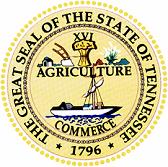 |
 |
 |
Tullahoma Campaign ~ Philip Henry Sheridan
108 Front St S, Cowan,
TN ,
USA
|
|

Tennessee State
Historical Marker
|
| |
| |
Tullahoma Campaign
June 24-July 4, 1863
? Philip Henry Sheridan ?
On 4 July 1863 Union Major General Philip Sheridan's 3rd Division (McCook's XX Corps) was stationed here in Cowan. This was the deepest advance of Union infantry in the Tullahoma Campaign. He and his men had crossed the Elk River just above Rock Creek on July 2nd, a day before marching on to Cowan.
It was fitting that Sheridan should be in the advance. He had risen dramatically to Major General. A West Point graduate who had lived an impoverished childhood, Sheridan became not only a talented leader, but a commander notable for his ruthless approach to fighting. In 1864, Sheridan moved east and was named by General Ulysses Grant chief of the Cavalry Corps of the Army of the Potomac. There he concentrated on destroying the farms, livestock, and homes in the Shenandoah Valley that provided much-needed supplies to Robert E. Lee's Army of Northern Virginia.
In the 1870s Sheridan would unleash his merciless view of waging war on the Plains Indians. As Commander of the Department of Missouri from 1869 to 1883, Sheridan was an unapologetic supporter of vanquishing Native American tribes. In 1875, he addressed a Texas legislature that was considering regulating the poaching of buffalo, the main source of food for Indians. Sheridan told the lawmakers that poachers should be left alone to ?kill, skin, and sell until they have
exterminated the buffalo. Then your prairies will be covered with speckled cattle and the festive cowboy, who follows the hunter as a second forerunner of civilization.?
(sidebar)
A Railroad War
By the late 1840s, politicians and businessmen across the country understood the potential power of the railroad. As improved technology made trains faster and more dependable, it became apparent that rivers and roads were increasingly inadequate as transportation corridors for trade. Thus, town ?boosters? worked feverishly to bring the railroad to their communities and not be left behind by the power of the ?iron horse.?
Nashville, the state capitol, was no exception. Promoters of Tennessee's first railroad, the Nashville and Chattanooga, labored in the late 1840s and early 1850s to connect the city to the major east-west line, the Memphis and Charleston, at Stevenson, Alabama. Construction, however, meant blasting a 2228-foot tunnel beneath the Cumberland Plateau, just south of Cowan, in an era before modern high explosive. In 1854, Samuel F. Tracy, a New Yorker, created the Sewanee Mining Company to extract coal from the plateau. In the process a spur line was constructed just north of the tunnel, up the plateau, to the town that today bears the company founder's name, Tracy City.
With the railroad complete in the mid-1850s, Chattanooga was a junction to four major railroads. During the war the Union Army of the Cumberland and the Confederate Army of Tennessee essentially fought for control of the line from late 1862 through late 1863. Even after the Union Army captured Chattanooga in November 1863, the line continued to attract attention from both sides. Only Union Commander William T. Sherman's ?March to the Sea? from Atlanta to Savannah in late 1864 secured the railroad against constant guerilla and cavalry activity.
Erected by Tennessee's Backroads Heritage.
Last updated: 2/14/2015 15:17:00 |
|
|
| |
|
Related Themes: C.S.A., Confederate States of America, Confederacy, Union States
Explore other
Tennessee Civil War Historical Markers.
|
| |
|
|
|
|
|


